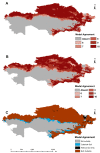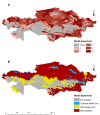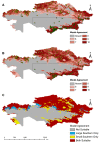Ecological niche modelling of the Bacillus anthracis A1.a sub-lineage in Kazakhstan
- PMID: 22152056
- PMCID: PMC3260114
- DOI: 10.1186/1472-6785-11-32
Ecological niche modelling of the Bacillus anthracis A1.a sub-lineage in Kazakhstan
Abstract
Background: Bacillus anthracis, the causative agent of anthrax, is a globally distributed zoonotic pathogen that continues to be a veterinary and human health problem in Central Asia. We used a database of anthrax outbreak locations in Kazakhstan and a subset of genotyped isolates to model the geographic distribution and ecological associations of B. anthracis in Kazakhstan. The aims of the study were to test the influence of soil variables on a previous ecological niche based prediction of B. anthracis in Kazakhstan and to determine if a single sub-lineage of B. anthracis occupies a unique ecological niche.
Results: The addition of soil variables to the previously developed ecological niche model did not appreciably alter the limits of the predicted geographic or ecological distribution of B. anthracis in Kazakhstan. The A1.a experiment predicted the sub-lineage to be present over a larger geographic area than did the outbreak based experiment containing multiple lineages. Within the geographic area predicted to be suitable for B. anthracis by all ten best subset models, the A1.a sub-lineage was associated with a wider range of ecological tolerances than the outbreak-soil experiment. Analysis of rule types showed that logit rules predominate in the outbreak-soil experiment and range rules in the A1.a sub-lineage experiment. Random sub-setting of locality points suggests that models of B. anthracis distribution may be sensitive to sample size.
Conclusions: Our analysis supports careful consideration of the taxonomic resolution of data used to create ecological niche models. Further investigations into the environmental affinities of individual lineages and sub-lineages of B. anthracis will be useful in understanding the ecology of the disease at large and small scales. With model based predictions serving as approximations of disease risk, these efforts will improve the efficacy of public health interventions for anthrax prevention and control.
Figures






Similar articles
-
Predicting the Geographic Distribution of the Bacillus anthracis A1.a/Western North American Sub-Lineage for the Continental United States: New Outbreaks, New Genotypes, and New Climate Data.Am J Trop Med Hyg. 2020 Feb;102(2):392-402. doi: 10.4269/ajtmh.19-0191. Am J Trop Med Hyg. 2020. PMID: 31802730 Free PMC article.
-
Ecological niche modeling of Bacillus anthracis on three continents: evidence for genetic-ecological divergence?PLoS One. 2013 Aug 19;8(8):e72451. doi: 10.1371/journal.pone.0072451. eCollection 2013. PLoS One. 2013. PMID: 23977300 Free PMC article.
-
Modeling the potential distribution of Bacillus anthracis under multiple climate change scenarios for Kazakhstan.PLoS One. 2010 Mar 9;5(3):e9596. doi: 10.1371/journal.pone.0009596. PLoS One. 2010. PMID: 20231894 Free PMC article.
-
Spores and soil from six sides: interdisciplinarity and the environmental biology of anthrax (Bacillus anthracis).Biol Rev Camb Philos Soc. 2018 Nov;93(4):1813-1831. doi: 10.1111/brv.12420. Epub 2018 May 6. Biol Rev Camb Philos Soc. 2018. PMID: 29732670 Review.
-
The ecology of anthrax spores: tough but not invincible.Can Vet J. 1995 May;36(5):295-301. Can Vet J. 1995. PMID: 7773917 Free PMC article. Review.
Cited by
-
Elk Resource Selection and Implications for Anthrax Management in Montana.J Wildl Manage. 2016 Feb;80(2):235-244. doi: 10.1002/jwmg.1016. Epub 2015 Nov 6. J Wildl Manage. 2016. PMID: 29887642 Free PMC article.
-
Exploring environmental coverages of species: a new variable contribution estimation methodology for rulesets from the genetic algorithm for rule-set prediction.PeerJ. 2020 May 12;8:e8968. doi: 10.7717/peerj.8968. eCollection 2020. PeerJ. 2020. PMID: 32440371 Free PMC article.
-
Modeling of wildlife-associated zoonoses: applications and caveats.Vector Borne Zoonotic Dis. 2012 Dec;12(12):1005-18. doi: 10.1089/vbz.2012.0987. Epub 2012 Nov 30. Vector Borne Zoonotic Dis. 2012. PMID: 23199265 Free PMC article. Review.
-
The potential distribution of Bacillus anthracis suitability across Uganda using INLA.Sci Rep. 2022 Nov 19;12(1):19967. doi: 10.1038/s41598-022-24281-8. Sci Rep. 2022. PMID: 36402889 Free PMC article.
-
An Estimate of Global Anthrax Prevalence in Livestock: A Meta-analysis.Vet World. 2021 May;14(5):1263-1271. doi: 10.14202/vetworld.2021.1263-1271. Epub 2021 May 22. Vet World. 2021. PMID: 34220129 Free PMC article.
References
-
- Van Ness G, Stein CD. Soils of the United States favorable for Anthrax. J Am Vet Med Assoc. 1956;128:7–9. - PubMed
Publication types
MeSH terms
LinkOut - more resources
Full Text Sources

